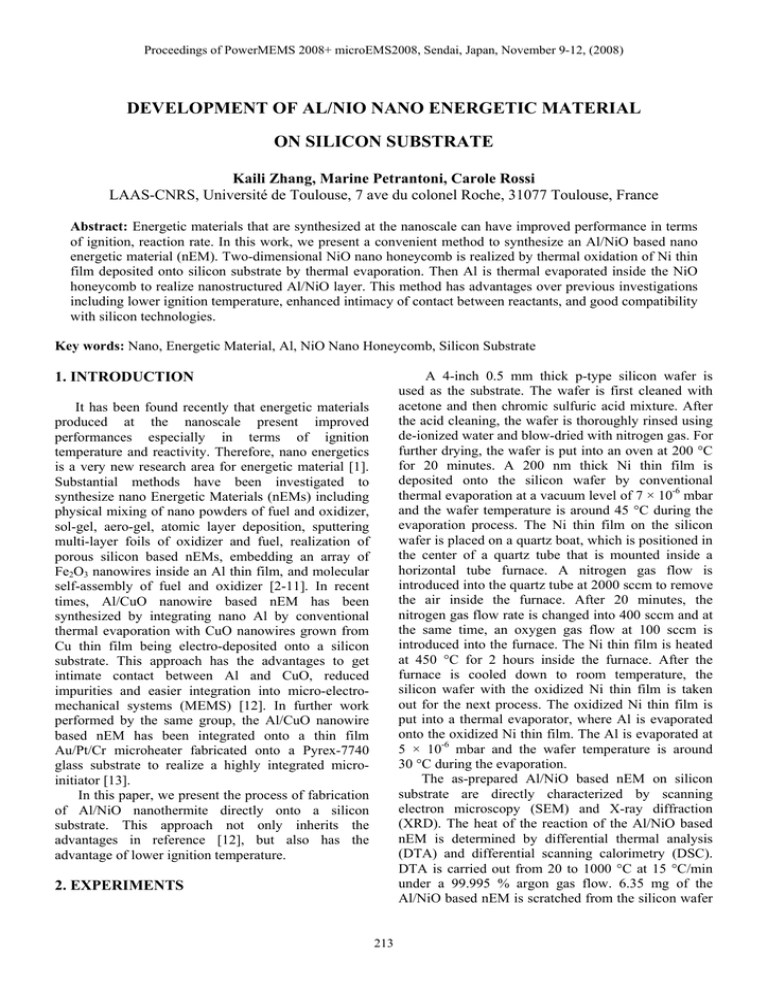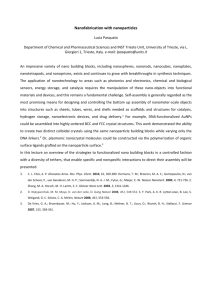DEVELOPMENT OF AL/NIO NANO ENERGETIC MATERIAL ON SILICON SUBSTRATE
advertisement

Proceedings of PowerMEMS 2008+ microEMS2008, Sendai, Japan, November 9-12, (2008) DEVELOPMENT OF AL/NIO NANO ENERGETIC MATERIAL ON SILICON SUBSTRATE Kaili Zhang, Marine Petrantoni, Carole Rossi LAAS-CNRS, Université de Toulouse, 7 ave du colonel Roche, 31077 Toulouse, France Abstract: Energetic materials that are synthesized at the nanoscale can have improved performance in terms of ignition, reaction rate. In this work, we present a convenient method to synthesize an Al/NiO based nano energetic material (nEM). Two-dimensional NiO nano honeycomb is realized by thermal oxidation of Ni thin film deposited onto silicon substrate by thermal evaporation. Then Al is thermal evaporated inside the NiO honeycomb to realize nanostructured Al/NiO layer. This method has advantages over previous investigations including lower ignition temperature, enhanced intimacy of contact between reactants, and good compatibility with silicon technologies. Key words: Nano, Energetic Material, Al, NiO Nano Honeycomb, Silicon Substrate A 4-inch 0.5 mm thick p-type silicon wafer is used as the substrate. The wafer is first cleaned with acetone and then chromic sulfuric acid mixture. After the acid cleaning, the wafer is thoroughly rinsed using de-ionized water and blow-dried with nitrogen gas. For further drying, the wafer is put into an oven at 200 °C for 20 minutes. A 200 nm thick Ni thin film is deposited onto the silicon wafer by conventional thermal evaporation at a vacuum level of 7 × 10-6 mbar and the wafer temperature is around 45 °C during the evaporation process. The Ni thin film on the silicon wafer is placed on a quartz boat, which is positioned in the center of a quartz tube that is mounted inside a horizontal tube furnace. A nitrogen gas flow is introduced into the quartz tube at 2000 sccm to remove the air inside the furnace. After 20 minutes, the nitrogen gas flow rate is changed into 400 sccm and at the same time, an oxygen gas flow at 100 sccm is introduced into the furnace. The Ni thin film is heated at 450 °C for 2 hours inside the furnace. After the furnace is cooled down to room temperature, the silicon wafer with the oxidized Ni thin film is taken out for the next process. The oxidized Ni thin film is put into a thermal evaporator, where Al is evaporated onto the oxidized Ni thin film. The Al is evaporated at 5 × 10-6 mbar and the wafer temperature is around 30 °C during the evaporation. The as-prepared Al/NiO based nEM on silicon substrate are directly characterized by scanning electron microscopy (SEM) and X-ray diffraction (XRD). The heat of the reaction of the Al/NiO based nEM is determined by differential thermal analysis (DTA) and differential scanning calorimetry (DSC). DTA is carried out from 20 to 1000 °C at 15 °C/min under a 99.995 % argon gas flow. 6.35 mg of the Al/NiO based nEM is scratched from the silicon wafer 1. INTRODUCTION It has been found recently that energetic materials produced at the nanoscale present improved performances especially in terms of ignition temperature and reactivity. Therefore, nano energetics is a very new research area for energetic material [1]. Substantial methods have been investigated to synthesize nano Energetic Materials (nEMs) including physical mixing of nano powders of fuel and oxidizer, sol-gel, aero-gel, atomic layer deposition, sputtering multi-layer foils of oxidizer and fuel, realization of porous silicon based nEMs, embedding an array of Fe2O3 nanowires inside an Al thin film, and molecular self-assembly of fuel and oxidizer [2-11]. In recent times, Al/CuO nanowire based nEM has been synthesized by integrating nano Al by conventional thermal evaporation with CuO nanowires grown from Cu thin film being electro-deposited onto a silicon substrate. This approach has the advantages to get intimate contact between Al and CuO, reduced impurities and easier integration into micro-electromechanical systems (MEMS) [12]. In further work performed by the same group, the Al/CuO nanowire based nEM has been integrated onto a thin film Au/Pt/Cr microheater fabricated onto a Pyrex-7740 glass substrate to realize a highly integrated microinitiator [13]. In this paper, we present the process of fabrication of Al/NiO nanothermite directly onto a silicon substrate. This approach not only inherits the advantages in reference [12], but also has the advantage of lower ignition temperature. 2. EXPERIMENTS 213 Proceedings of PowerMEMS 2008+ microEMS2008, Sendai, Japan, November 9-12, (2008) for the DTA testing. DSC is performed from 20 to 700°C at 5 °C/min under a 99.999 % nitrogen gas flow with 2.3 mg Al/NiO based nEM. 3. RESULTS 3.1 SEM Characterization Figure 1(a) shows a 30o tilted view SEM image of the oxidized Ni thin film. After the thermal oxidation the thin film becomes porous and honeycomb-like structure is formed with a wall thickness of 50-150 nm. It is also shown by experiments that relatively uniform nano honeycomb can be formed all through the entire thin film surface deposited on a 4-inch silicon wafer. Consequently, the process described in this work is suitable for batch fabrication and mass production. Figure 1(b) is a cross-sectional view SEM image of the thermally oxidized Ni thin film. It is shown that some of the nano holes extend through the entire thin film. And the oxidized thin film thickness is increased by more than two times compared to the deposited Ni thin film because of the nano honeycomb-like structure created. Fig. 1: SEM images of the oxidized Ni thin film at 450 o C for 2h: (a) 30o tilted view and (b) cross-sectional view. The 30o tilted view and cross-sectional view SEM images of the nano honeycomb after Al deposition is shown in Fig. 2 (a) and (b), respectively, where the average thickness of the thermally evaporated Al is 210 nm. It can be clearly seen that the Al is intimately integrated with the nano honeycomb, which results in the intimate interfacial contact between the Al and the nano honeycomb. The as-prepared material is characterized by XRD (not shown here) and Al and NiO are confirmed to be the only components of the material. 214 Proceedings of PowerMEMS 2008+ microEMS2008, Sendai, Japan, November 9-12, (2008) Fig. 2: SEM images of the oxidized Ni thin film at 450 o C for 2h after Al integration: (a) 30o tilted view and (b) cross-sectional view. Fig. 3: DSC plot of the exothermic reactions of the Al/NiO based nEM. 3.2 DSC and DTA Characterizations Figure 3 shows the exothermic reactions of the Al/NiO based nEM characterized by DSC. It is shown that there are two major exotherms associated with the thermite reactions. The first exotherm is with an onset temperature of around 400 °C and the second one is with an onset temperature of around 530 °C, which are below the melting temperature of bulk Al (~ 660 °C). Therefore, the Al/NiO based nano energetic composite seems to react before the melting of Al. This suggests that the two exotherms are caused by the thermite reactions between the Al and the NiO nano honeycomb structures, which are based on the solidsolid diffusion mechanism. Consequently, the ignition temperature of Al/NiO based nano thermite composite is significantly reduced by creating nano-structured NiO honeycombs. The increased surface energy of the NiO nanohoneycomb structures and nano Al enhances their reactivity and stimulates the reduced ignition temperature. The exothermic reactions of the Al/NiO based nEM are also characterized by DTA (not shown here). Combination of DSC and DTA allows roughly estimating the total heat of the reaction of the Al/NiO based nEM to be around 2200 J/g. The value is below the theoretical heat of the reaction (3400 J/g) between Al and NiO. The low heat of the reaction is mainly due to two factors. One is that the gases used for DSC and DTA contain some oxygen that oxidizes the evaporated Al during the heating process. The other is that the masses of NiO and Al in the Al/NiO based nEM are not at the stoichiometric ratio. 3.3 XRD Characterization after Thermite Reaction Figure 4 shows the XRD pattern of the Al/NiO based nEM after thermite reactions. The reaction products are Al2O3, Ni, NiO, and SiO2, which are corresponding to the reaction: 2Al + 3NiO → Al2O3 + 3Ni. SiO2 is due to the oxidation of Si scratched from the silicon substrate. The peaks of NiO are probably caused by the redundant unreacted NiO or the oxidation of the reaction product Ni. Fig. 4: XRD pattern of the Al/NiO based nEM after thermite reactions 215 Proceedings of PowerMEMS 2008+ microEMS2008, Sendai, Japan, November 9-12, (2008) thermite materials”, Powder Technology, vol. 156, pp. 154-163, 2005. [7] M.L. Pantoya and J.J. Granier, “Combustion behavior of highly energetic thermites: nano versus micron composites”, Propellants Explosives Pyrotechnics, vol. 30, pp. 53-62, 2005. [8] B.S. Bockmon, M.L. Pantoya, S.F. Son, B.W. Asay, and J.T. Mang, “Combustion velocities and propagation mechanisms of metastable interstitial composites”, Journal of Applied Physics, vol. 98, 064903 (7pp), 2005. [9] A. Prakash, A.V. McCormick, and M.R. Zachariah, “Tuning the reactivity of energetic nanoparticles by creation of a core-shell nanostructure”, Nano Letters, vol. 5, pp. 1357-1360, 2005. [10] A. Hofmann, H. Laucht, D. Kovalev, V.Y. Timoshenko, J. Diener, N. Kunzner, and E. Gross, “Explosive composition and its use”, U.S. Patent 6 984 274, Jan. 10, 2006. [11] S. Apperson, R.V. Shende, S. Subramanian, D. Tappmeyer, S. Gangopadhyay, Z. Chen, K. Gangopadhyay, P. Redner, S. Nicholich, and D. Kapoor, “Generation of fast propagating combustion and shock waves with copper oxide/aluminum nanothermite composites”, Applied Physics Letters, vol. 91, 243109 (3pp), 2007. [12] K. Zhang, C. Rossi, C. Tenailleau, P. Alphonse, and G.A.A. Rodriguez, “Development of a nano Al/CuO based energetic material on silicon substrate”, Applied Physics Letters, vol. 91, 113117 (3pp), 2007. [13] K. Zhang, C. Rossi, M. Petrantoni, and N. Mauran “A nano initiator realized by integrating Al/CuObased nanoenergetic materials with a Au/Pt/Cr microheater”, Journal of Microelectromechanical Systems, vol. 17, pp. 832-836, 2008. 4. CONCLUSION Al/NiO based nano energetic material has been synthesized by integrating Al with NiO nano honeycomb grown from Ni thin film deposited onto a silicon substrate by thermal evaporation. The Ni thin film is changed into porous NiO nano honeycomb structure after the thermal oxidation. Al is intimately integrated with the NiO nano honeycomb by conventional thermal evaporation, which results in improved interfacial contact between the Al and the NiO nano honeycomb. DSC testing shows that the Al reacts with the NiO nano honeycomb with an onset temperature of around 400 °C, which is below the melting temperature of Al (~ 660 °C for bulk). This suggests that the thermite reactions are based on the solid-solid diffusion mechanism. The total heat of the reaction of the thermite reactions is estimated to be about 2200 J/g by combining DSC and DTA tests. The as-synthesized Al/NiO based nano energetic material has several advantages including lowered ignition temperature, enhanced interfacial contact, and easier combination with MEMS. REFERENCES [1] C. Rossi, K. Zhang, D. Estève, P. Alphonse, J.Y.C. Ching, P. Tailhades, and C. Vahlas, “Nano energetic materials for MEMS: a review”, Journal of Microelectromechanical Systems, vol. 16, pp. 919-931, 2007. [2] T.M. Tillotson, A.E. Gash, R.L. Simpson, L.W. Hrubesh, J.H. Satcher Jr., and J.F. Poco, “Nanostructured energetic materials using sol-gel methodologies”, Journal of Non-Crystalline Solids, vol. 285, pp. 338-345, 2001. [3] K.J. Blobaum, M.E. Reiss, J.M.P. Lawrence, and T.P. Weihs, “Deposition and characterization of a self-propagating CuOx/Al thermite reaction in a multilayer foil geometry”, Journal of Applied Physics, vol. 94, pp. 2915-2922, 2003. [4] L. Menon, S. Patibandla, K. Bhargava Ram, S.I. Shkuratov, D. Aurongzeb, M. Holtz, J. Berg, J. Yun, and H. Temkin, “Ignition studies of Al/Fe2O3 energetic nanocomposites”, Applied Physics Letters, vol. 84, pp. 4737-4737, 2004. [5] S.H. Kim and M.R. Zachariah, “Enhancing the rate of energy release from nano energetic materials by electrostatically enhanced assembly”, Advanced Materials, vol. 16, pp. 1821-1825, 2004. [6] J.D. Ferguson, K.J. Buechler, A.W. Weimer, and S.M. George, “SnO2 atomic layer deposition on ZrO2 and Al nanoparticles: pathway to enhanced 216



